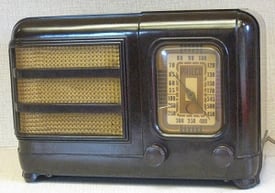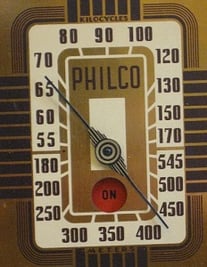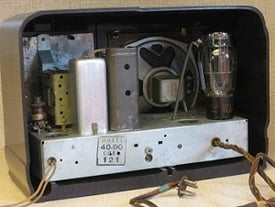Vintage Audio: Radio Down on the Farm | Telos Alliance
By The Telos Alliance Team on Feb 18, 2016 9:34:48 PM
 Vintage Audio: Radio Down on the Farm
Vintage Audio: Radio Down on the Farm
This episode of Found in the Attic features a 1940 tabletop radio with a twist. This Philco model 40-90 is a farm radio. Although they were an important part of radio history, these radios are largely forgotten today.
When radio came on the scene in the 1920s, it was the first mass media. It brought Americans together as never before. Suddenly, geographic boundaries didn't matter. Once the sun went down, clear channel AM radio stations sent their signals coast to coast.
The first radio receivers from the 1920s ran on batteries. But batteries were expensive, and had a comparatively short life. They were also complicated for the average consumer to connect properly. There were A, B and C batteries, for filament, plate and bias supplies respectively. Radio batteries had terminals or Fahnestock clips, and most radios had color-coded leads. Often there was a wiring diagram pasted to the back of the receiver. Despite this, early electronics was like black magic to the average consumer of the 1920s.
Mistakes in connecting batteries could be fatal to the receiver. Hook that 90-volt B battery to the 1.5-volt filament A terminals by mistake, and you would probably blow out the filaments in one or more of those expensive tubes. Polarity reversals when connecting the battery usually meant the radio wouldn't work at all. So it was no surprise that as AC power became commonplace, radios included an internal power supply, and soon became one of the appliances you could just plug in. Problem solved? Not really.
In the 1920s and 30s, a large percentage of the American population lived on farms, and less than ten percent of those had electricity. That meant that a lot of people could not listen to radio, although they really wanted to.
Farmers didn't make a lot of money, radios and their batteries were expensive. They also didn't last very long. In addition to the cost, there was usually no place locally to purchase them. As a result, the number of farms that had a working radio was minimal.
That was soon to change, as economic and technological events took shape. The stock market crash of 1929 and resultant Great Depression drove the cost of radios down to the point that they were affordable by most farmers. And the invention of the vibrator in 1933 eliminated the need for the high voltage 'B' battery. A vibrator is a device that takes a DC voltage as its input, and supplies a 60 Hz AC square wave as its output.
And so the farm radio began to develop. The 6 or 12-vo lt battery was still used to power the tube filaments, and now the vibrator, whose low AC voltage was stepped up to around 250 volts. These devices became known as 'single battery radios'. Instead of an AC power cord, these radios had a cord with alligator clips.
lt battery was still used to power the tube filaments, and now the vibrator, whose low AC voltage was stepped up to around 250 volts. These devices became known as 'single battery radios'. Instead of an AC power cord, these radios had a cord with alligator clips.
Virtually all farms had tractors, and these tractors had 6 or 12-volt batteries. It was a simple matter to bring these batteries in to the farmhouse in the evening and connect them to the radio. In the morning, they usually had enough juice left to start the tractor.
The Zenith Radio Corporation was a pioneer in the development of farm radios. As a shrewd bit of marketing, the company manufactured many of their sets in two versions, one with the conventional AC supply that plugged in, and the second with a vibrator supply, sold as a farm radio. It wasn't long before other manufacturers got in on the act, including Emerson, Philco, Stromberg Carlson and RCA.
While all of this was going on, the technology of batteries and vacuum tubes was evolving. That confusing mass of A, B and C batteries and their wiring became consolidated. B and C batteries were just a group of 1.5-volt A cells connected in series or series-parallel. It was just a matter of packaging to put the A and B cells in one container. The next step was standardized connectors on both the batteries and radios. Soon, changing batteries was a simple plug and play operation. What didn't change was the basic1.5-volt alkaline cells. The battery footprint got smaller with A-B packs, but the weight was still an issue.
The power consumption of vacuum tubes was also reduced. A new generation of tubes was developed for portables and farm sets. Rather than the usual 6-volt filament, these tubes had octal bases and 1.5 volt filaments. As a result, the weight and size of radio batteries got a bit smaller.
The A-B batteries came in two varieties. One was for portable receivers. These were a compromise between size and long life. The second was for farm radios, and were known as 'farm packs'. Size didn't really matter, but long life did. Many of these farm packs were about 18 inches long and quite heavy.
As with the unlikely portables discussed in an earlier FitA, farm radios were manufactured for a relatively short period of time. The first ones were made in the mid 1930s. By the end of WW II, most of rural America had been electrified. Work would not be complete till the 1950s, but those farms without electricity were a shrinking minority. The need for farm radios simply went away. The laws of supply and demand took their toll on the A-B batteries as well. With the advent of transistor radios, sales of those larger batteries began to fall off. A few were available through the mid 1960s, but not for long.
The technological legacy of farm radios was the vibrator-powered car radio, and also a new generation of even smaller 1.5-volt tubes with loktal bases, such as the 1LH4, 1LN6 and 1LC5.
Farm radios were important not only because of the technological advances in vacuum tube and receiver technology they helped bring about, but also because of their social impact, and influence on radio programming. Before radio, information reached rural communities largely via newspapers, and news could take days or even weeks to reach isolated communities. Farm radios brought these rural communities into the world of instant communications, and quickly leveled the playing field between the haves and have nots as far as information access.
Many radio stations of the day devoted a considerable amount of air time to program ming to meet the needs of farming communities. There were detailed weather reports, along with suggestions on the best time to plant crops. Research on agricultural sciences at many of the land-grant universities was in full swing, and there were often reports from extension agents on recent developments in livestock and crops.
ming to meet the needs of farming communities. There were detailed weather reports, along with suggestions on the best time to plant crops. Research on agricultural sciences at many of the land-grant universities was in full swing, and there were often reports from extension agents on recent developments in livestock and crops.
Our model 40-90 sold for $24, and was simplicity in itself. It was a four-tube superhet covering just the AM band. Tube lineup was a 1A7, 1N5, 1H5 and 1A5. There was no internal antenna, just wires for ground and antenna.
This radio was purchased at an auction for something like 75 cents. That price included the farm pack battery, which is probably still lost in the unexplored sections of the attic. Cosmetically, this receiver is in good condition. The filament was out on the 1N5, but once that was replaced, the radio worked when connected to a makeshift power supply. With plenty of AC-powered radios and communications receivers to tinker with, the 40-90 was soon packed away and forgotten. Now it is being added to the permanent collection, and a tag is being prepared briefly describing the history of farm radios.
Telos Alliance has led the audio industry’s innovation in Broadcast Audio, Digital Mixing & Mastering, Audio Processors & Compression, Broadcast Mixing Consoles, Audio Interfaces, AoIP & VoIP for over three decades. The Telos Alliance family of products include Telos® Systems, Omnia® Audio, Axia® Audio, Linear Acoustic®, 25-Seven® Systems, Minnetonka™ Audio and Jünger Audio. Covering all ranges of Audio Applications for Radio & Television from Telos Infinity IP Intercom Systems, Jünger Audio AIXpressor Audio Processor, Omnia 11 Radio Processors, Axia Networked Quasar Broadcast Mixing Consoles and Linear Acoustic AMS Audio Quality Loudness Monitoring and 25-Seven TVC-15 Watermark Analyzer & Monitor. Telos Alliance offers audio solutions for any and every Radio, Television, Live Events, Podcast & Live Streaming Studio With Telos Alliance “Broadcast Without Limits.”
Recent Posts
Subscribe
If you love broadcast audio, you'll love Telos Alliance's newsletter. Get it delivered to your inbox by subscribing below!